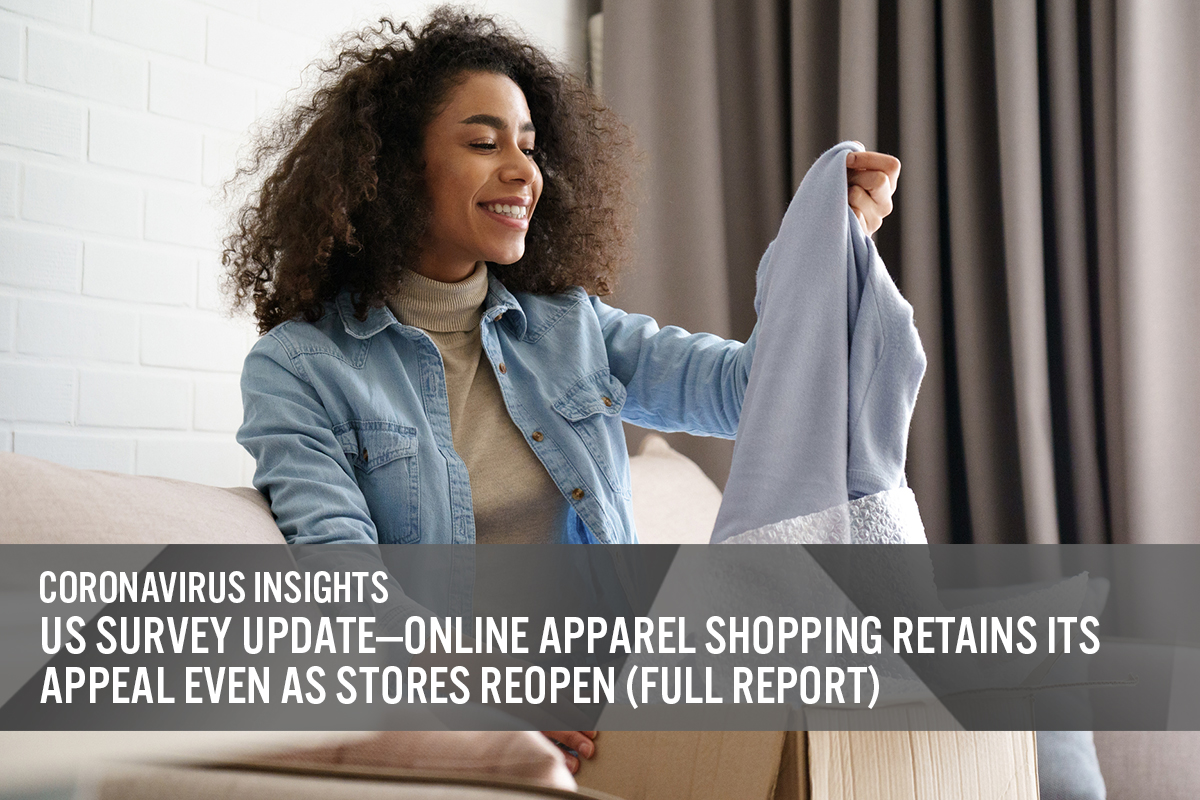
albert Chan
Introduction
This report presents the results of Coresight Research’s latest weekly survey of US consumers on the coronavirus outbreak, undertaken on June 24. This report explores the trends we are seeing from week to week, following prior surveys on June 17, June 10, June 3, May 27, May 20, May 13, May 6, April 29, April 22, April 15, April 8, April 1, March 25 and March 17–18.
Online Apparel Shopping Maintains Its Appeal
Many states in the US have announced easing of lockdown restrictions from the start of May, allowing apparel retailers to reopen their stores. However, we are not seeing any signs of a downward trend in online apparel shopping yet.
The proportion of respondents buying more apparel online than they used to jumped in the first half of May and was steady for subsequent weeks, before increasing again this week to more than one-quarter of all respondents—representing a roughly 10-percentage-point increase from May 6.
[caption id="attachment_112140" align="aligncenter" width="700"]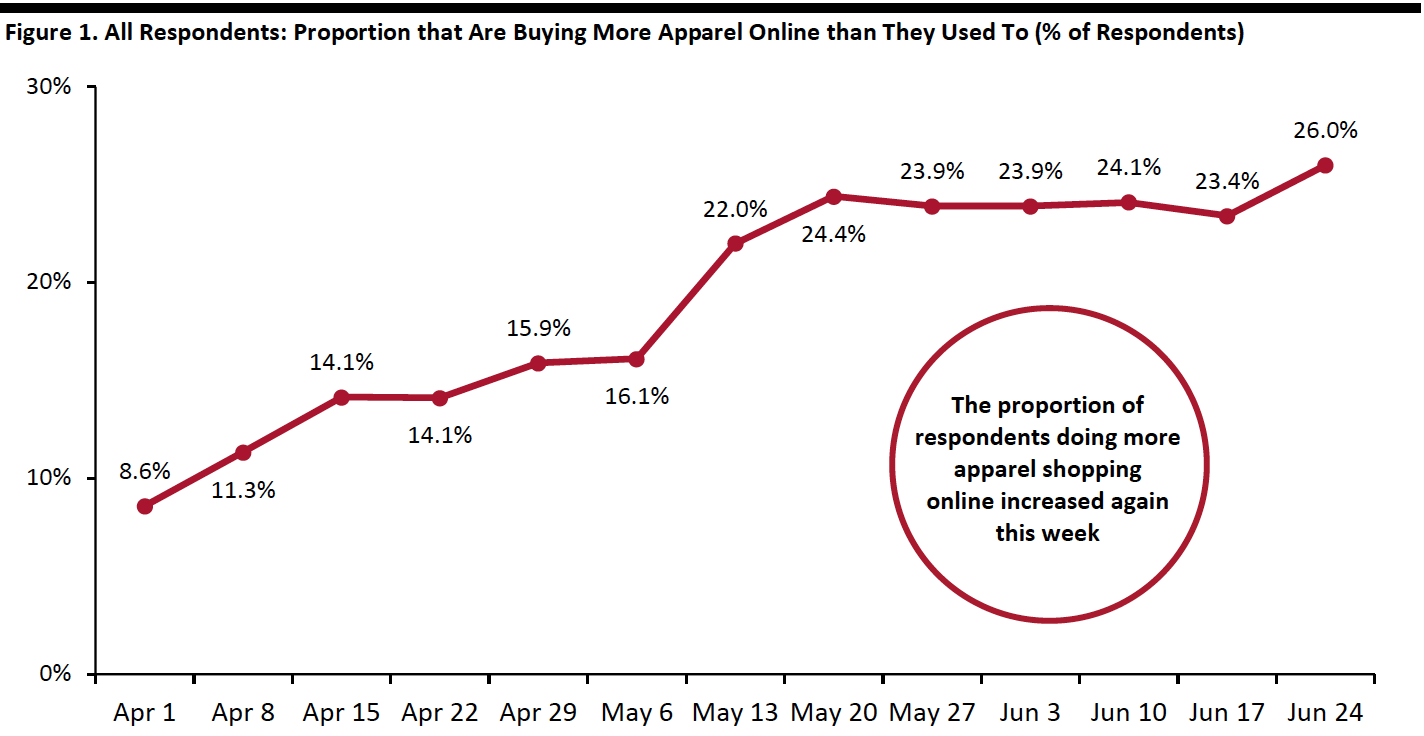 Base: US Internet users aged 18+
Base: US Internet users aged 18+Source: Coresight Research[/caption]
We also saw consistently strong demand for apparel online when we asked consumers what they have done in the past two weeks and what they expect to do in the next two weeks.
- Making online purchases of apparel topped the list of activities we asked respondents about, with a little over one-third saying that they had bought clothing or footwear online in the past two weeks—almost consistent with last week’s findings.
- Expectations to buy apparel online in the next two weeks remain steady from last week.
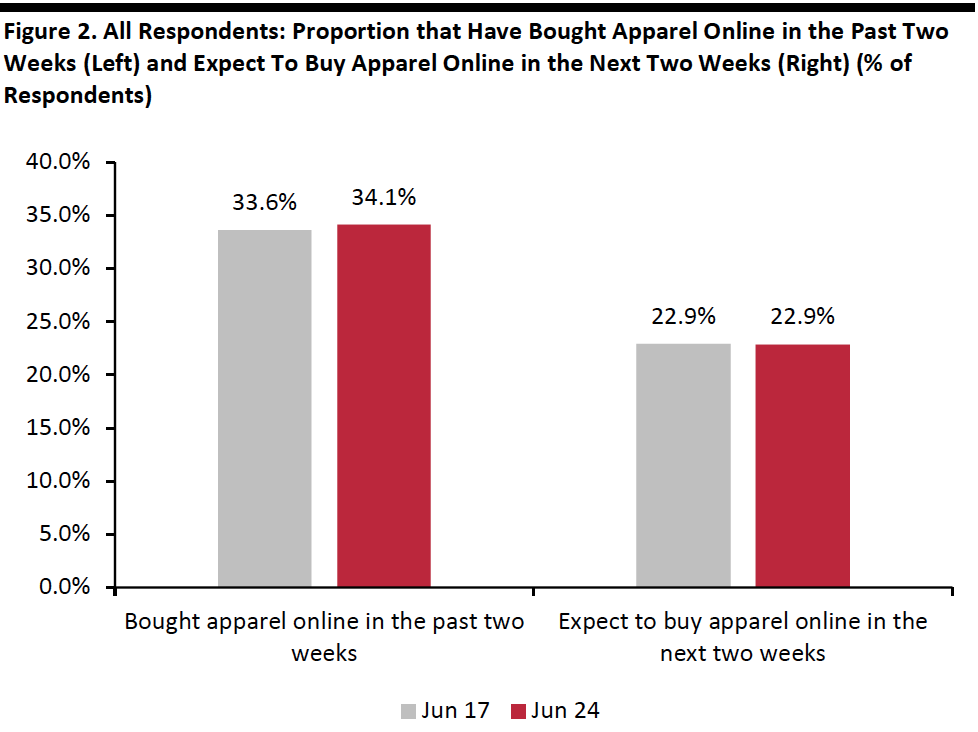 Base: US Internet users aged 18+
Base: US Internet users aged 18+Source: Coresight Research[/caption]
What Shoppers Are Doing and Where They Are Going
Almost One-Third of Respondents Shopped for Groceries Online in the Past Two Weeks
We provided respondents with 16 options and asked them which they had done in the past two weeks and which they expected to do in the next two weeks. We saw increases in the proportion of respondents doing eight of the 16 activities over the past two weeks.
- Online grocery shopping remains at elevated levels and was the second-most-popular spending-related activity after online shopping for clothing or footwear.
- While online apparel shopping has proved resilient, we are seeing a greater fluctuation in the proportion of respondents that bought apparel in a store. This week, some 17.5% of respondents reported that they bought apparel offline, down from 20.8% last week.
- The proportion of respondents that visited enclosed shopping centers is on an upward trend. This week, over one in 10 reported that they did so in the last two weeks.
- We noticed a slight uptick in the proportion of respondents that visited a restaurant in the past two weeks, with almost one-quarter reporting they have done so, versus 23.8% last week.
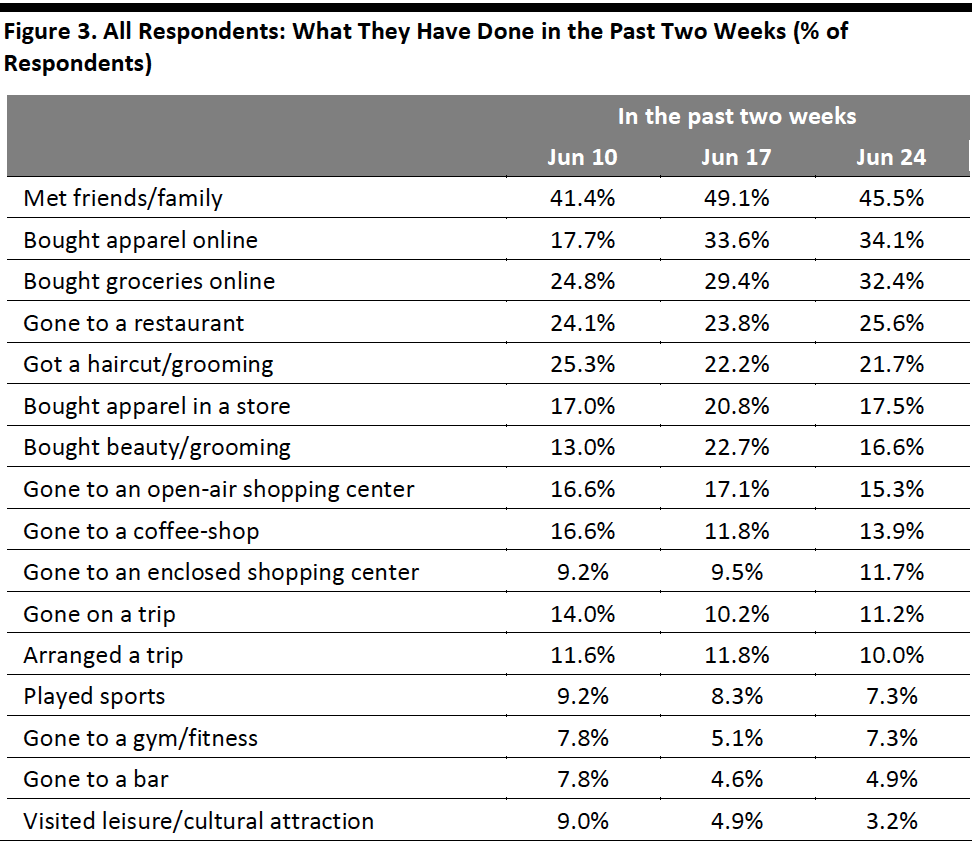 Respondents could select multiple options
Respondents could select multiple optionsBase: US Internet users aged 18+
Source: Coresight Research[/caption]
Almost One-Fifth of Respondents Plan To Buy Apparel in Store in the Next Two Weeks
Below, we chart what respondents have done in the past two weeks and what they expect to do in the next two weeks. Some 19% expect to buy clothing or footwear in store in the next two weeks—very slightly higher than expectations when we asked the question in the previous survey (and within the margin of error).
Fewer respondents expect to buy beauty products or visit an open-air shopping center in the next two weeks than the number of respondents that had done these activities over the prior two weeks: Some 12.2% expect to buy beauty products, while 16.6% had done so in the last two weeks.
[caption id="attachment_112143" align="aligncenter" width="700"]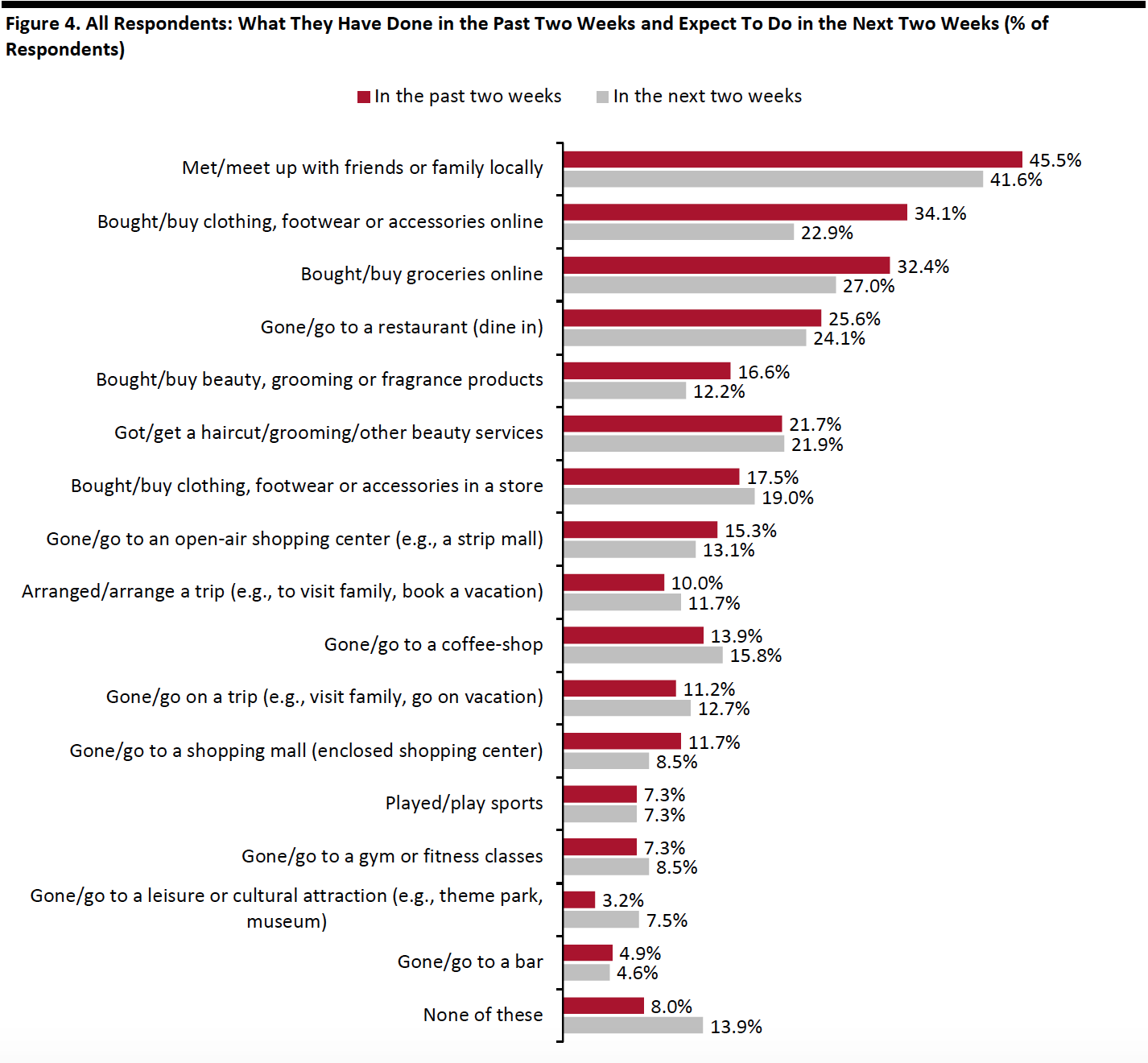 Respondents could select multiple options
Respondents could select multiple optionsBase: US Internet users aged 18+
Source: Coresight Research [/caption]
Eight in 10 Are Currently Avoiding Public Places
With many more businesses having reopened, we changed our “avoidance” question this week, from asking about which types of places respondents expect to avoid after lockdowns end to where they are currently avoiding.
Our findings suggest that consumers are still wary of visiting public places, with over 81.5% of respondents saying that they are currently avoiding doing so. Almost 59% stated that they are currently avoiding shopping centers/malls, making them the topmost avoided places. The leisure industry is also seeing large avoidance: More than half of respondents reported that they are presently avoiding food-service outlets and sports centers.
[caption id="attachment_112144" align="aligncenter" width="700"]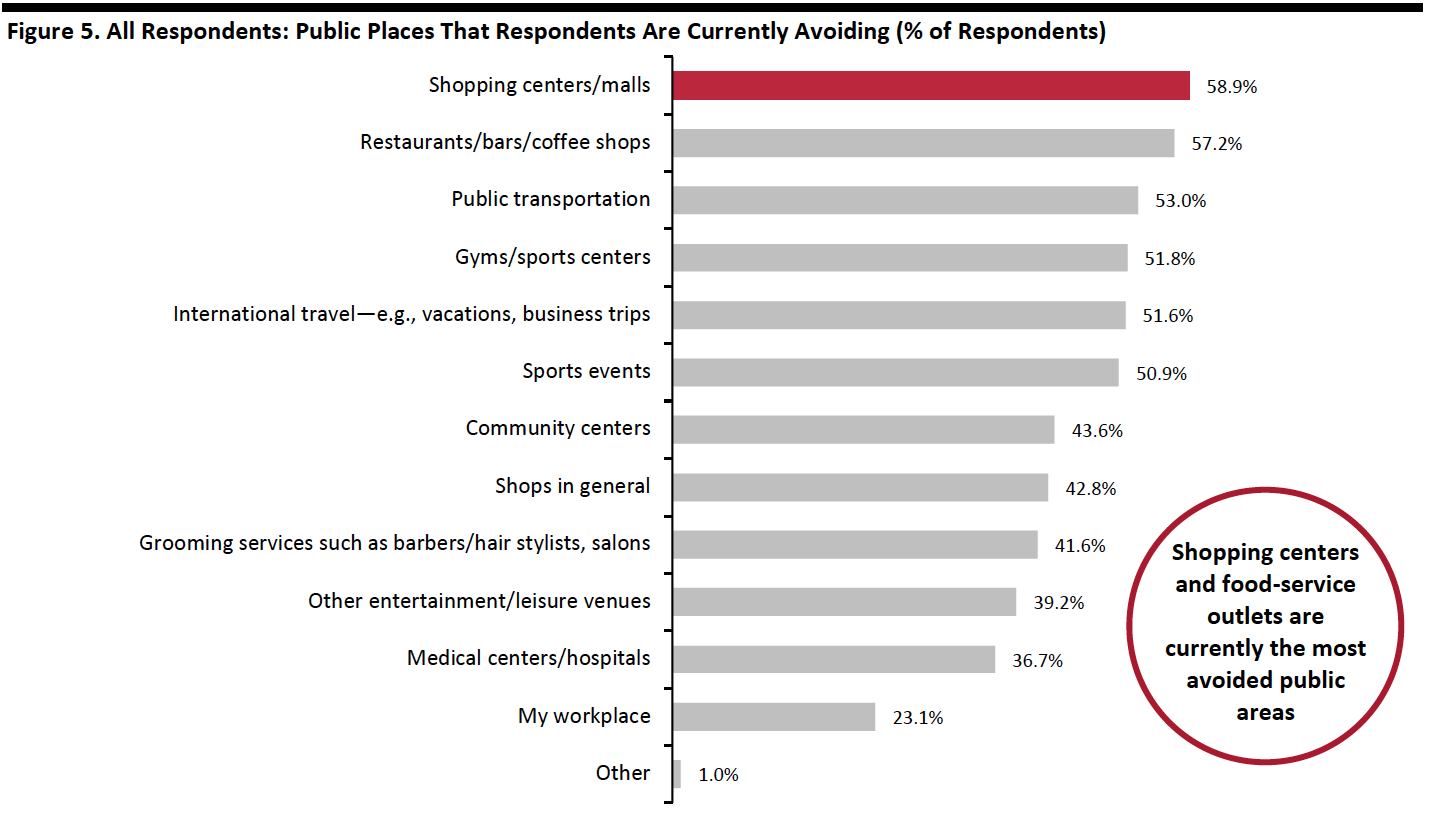 Respondents could select multiple options
Respondents could select multiple optionsBase: US Internet users aged 18+
Source: Coresight Research[/caption]
Trends in Purchasing Behavior
What They Are Currently Buying More Of and Less Of
Some 61.1% of all respondents said that they are currently buying more of some categories, while 51.6% said that they are currently buying less of some categories.
- Note, buying more of certain categories and buying less of certain categories were not mutually exclusive options, so respondents could answer yes to both.
Buying more: Essentials, including household products, food, personal care and health products, are the top categories that consumers are currently buying more of: More than one-third of all respondents reported that they are buying more products in these categories.
Buying less: Discretionary categories such as apparel, home and beauty products are the top categories that customers are currently buying less of: Apparel is the most-cut category, with more than one-quarter of respondents saying that they are currently purchasing less apparel.
Ratio of less to more: Apparel recorded the highest disproportionate parity between buying less/more, with 3.1 times as many respondents answering “less” as answering “more,” followed by beauty products at 2.9. The essentials categories saw the lowest ratios, with all of these recording ratios of lower than one.
[caption id="attachment_112145" align="aligncenter" width="700"]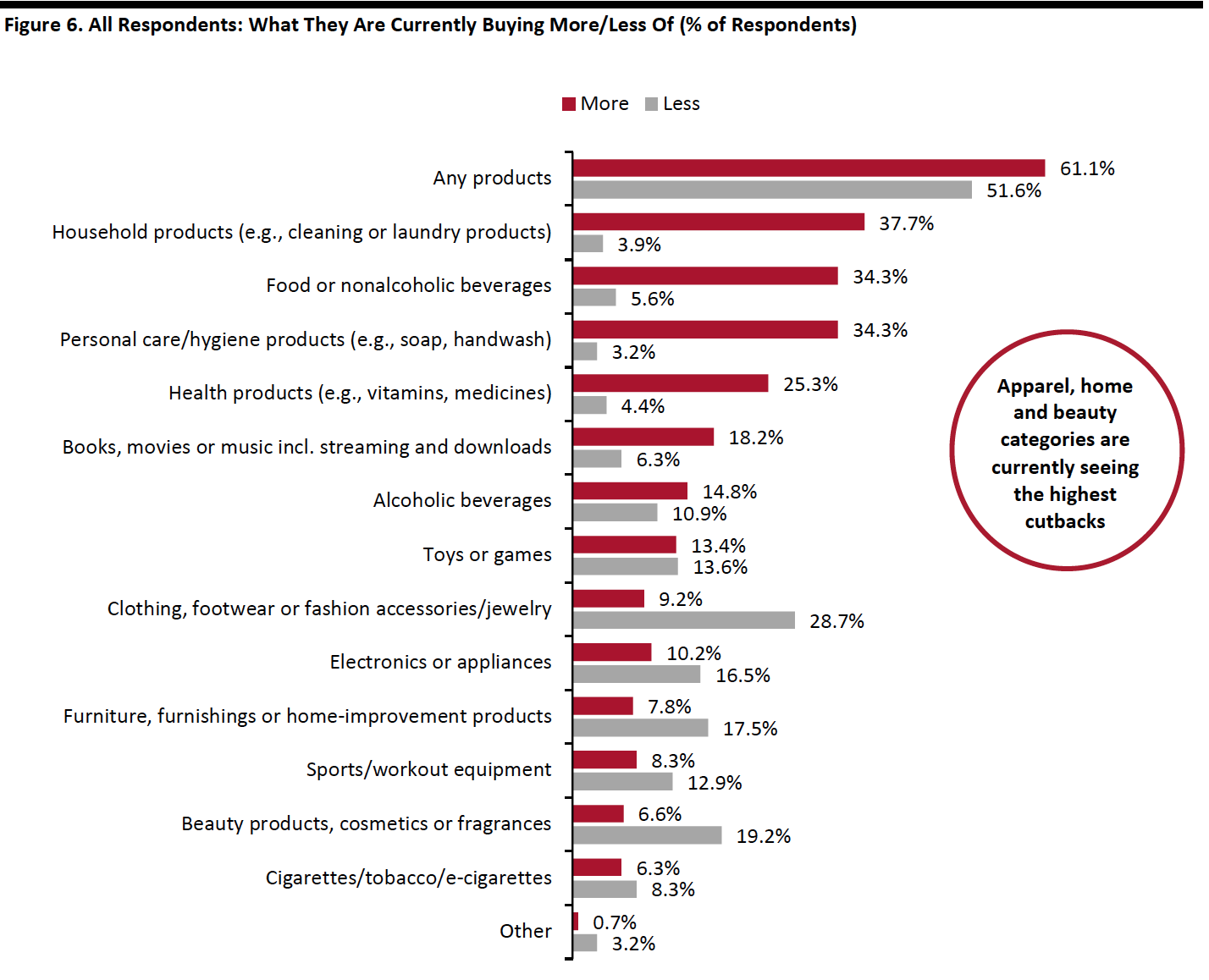 Respondents could select multiple options
Respondents could select multiple optionsBase: US Internet users aged 18+
Source: Coresight Research[/caption]
More Than Three-Quarters Are Switching Spending Online
The proportion of consumers switching their spending to e-commerce remained high this week, even though most states have eased or lifted lockdowns. Some 76.4% of consumers stated that they are buying more online this week, versus 69.9% last week.
[caption id="attachment_112146" align="aligncenter" width="700"]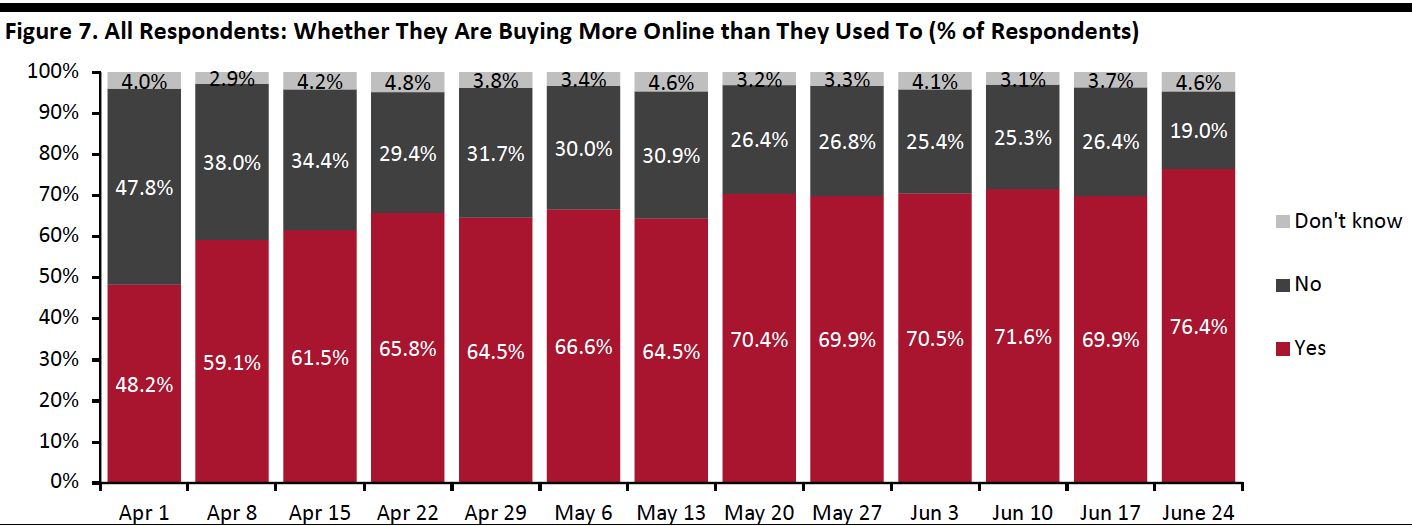 Base: US Internet users aged 18+
Base: US Internet users aged 18+Source: Coresight Research[/caption]
What Consumers Are Currently Buying More Of Online
Unsurprisingly, essentials such as household products, personal hygiene products and food feature prominently in online shopping, with more than one-third of respondents reporting they are currently buying more household and personal hygiene products online than they used to, while a little more than one-quarter of respondents are currently buying more food online.
In discretionary categories, 26.0% of respondents reported that they are currently buying more apparel online, followed by 18.2% for beauty products.
[caption id="attachment_112147" align="aligncenter" width="700"]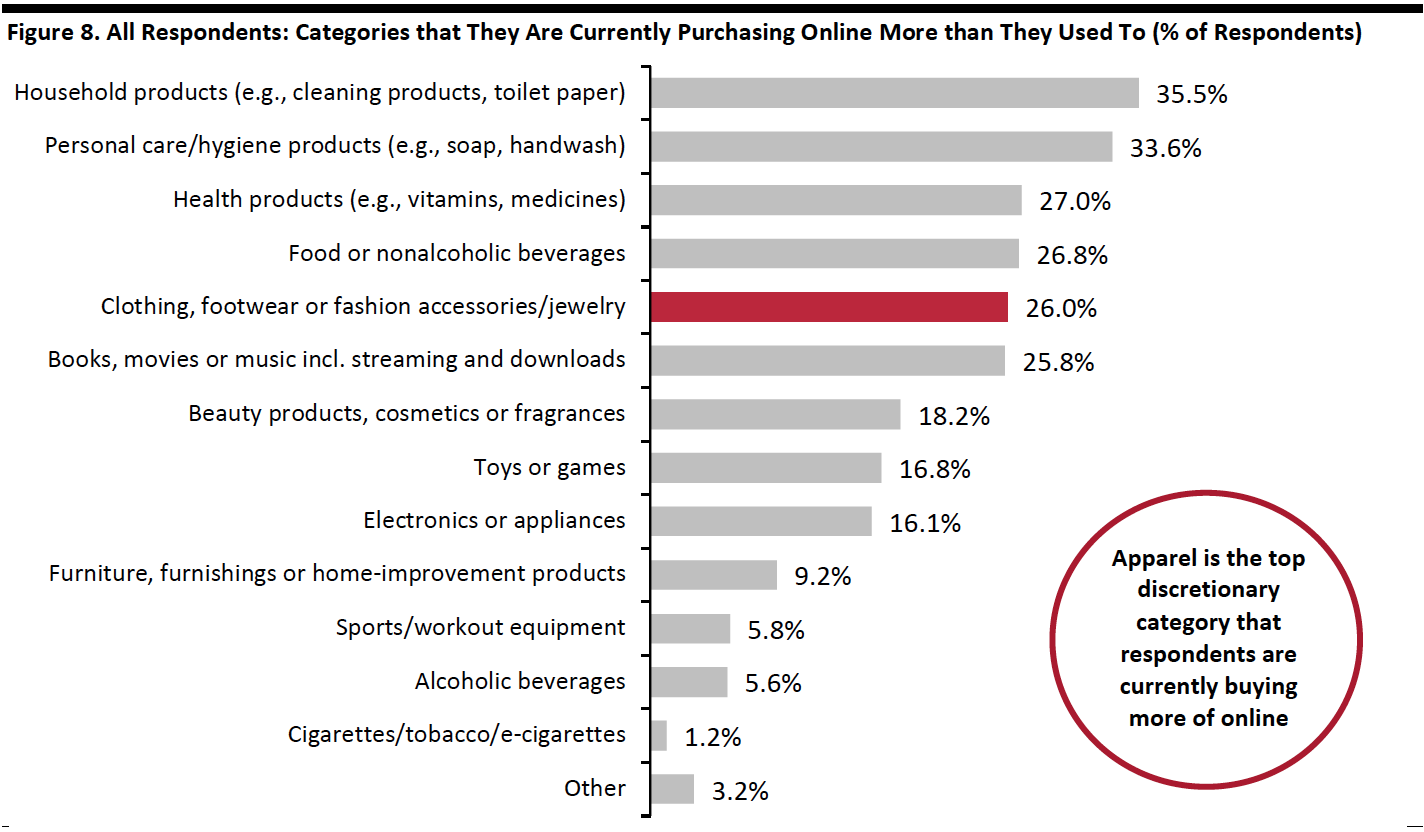 Respondents could select multiple options
Respondents could select multiple optionsBase: US Internet users aged 18+
Source: Coresight Research[/caption]
Expected Future Behaviors
Six in 10 Expect To Retain Changed Behaviors over the Long Term
Each week, we ask respondents whether they think they will keep some of the behaviors they have adopted during the coronavirus crisis. This week, the proportion of respondents expecting to retain some changed behavior fell below 60% for the first time since April 8, with 58.9% expecting to do so for the long term. The downward trend over the last two weeks could hint that US consumers are now slightly more willing to return to their normal life than they used to be.
[caption id="attachment_112148" align="aligncenter" width="700"]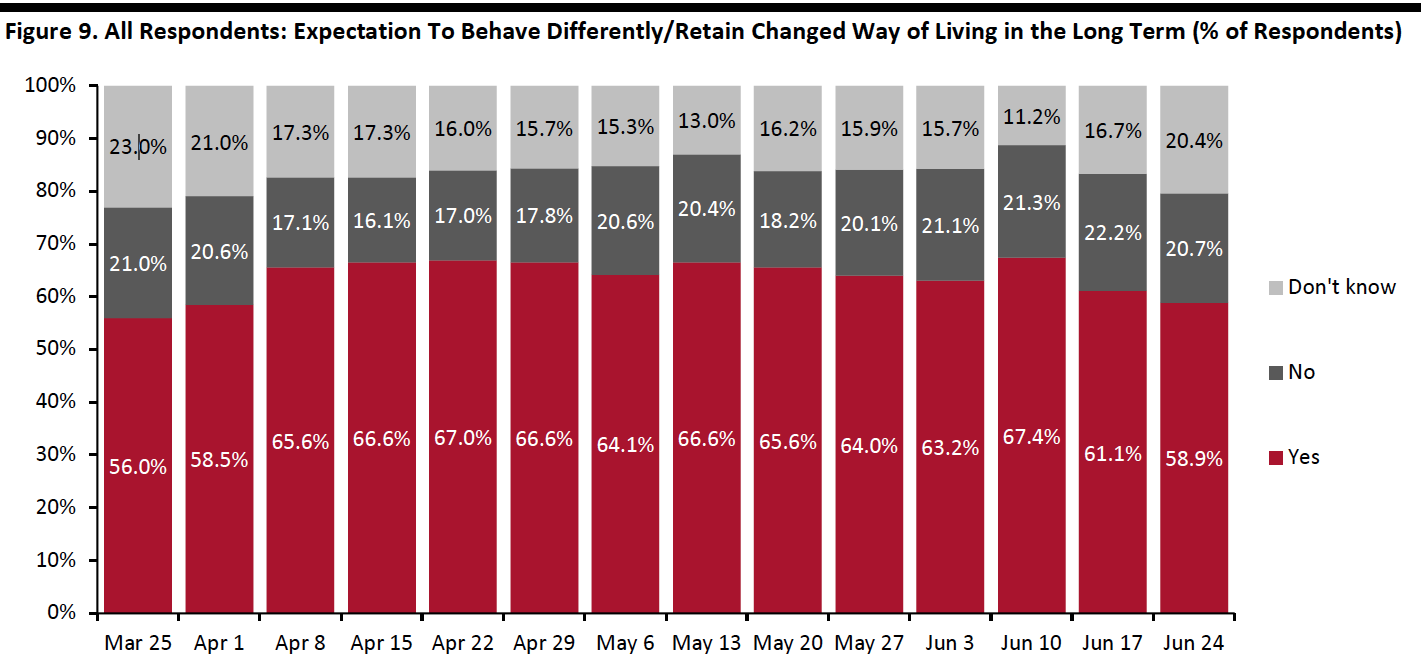 Base: US Internet users aged 18+
Base: US Internet users aged 18+Source: Coresight Research[/caption]
Among those expecting to retain changed behaviors, over half expect to focus more on health and wellbeing, which is almost consistent with the last week.
The proportion of respondents expecting to wear masks/gloves leveled off after showing an upward trend, with half of respondents expecting to do so in the long term.
The proportion of respondents expecting to use contactless payment options in stores more often than they did previously decreased this week to 38% from 42.4% last week.
[caption id="attachment_112149" align="aligncenter" width="700"]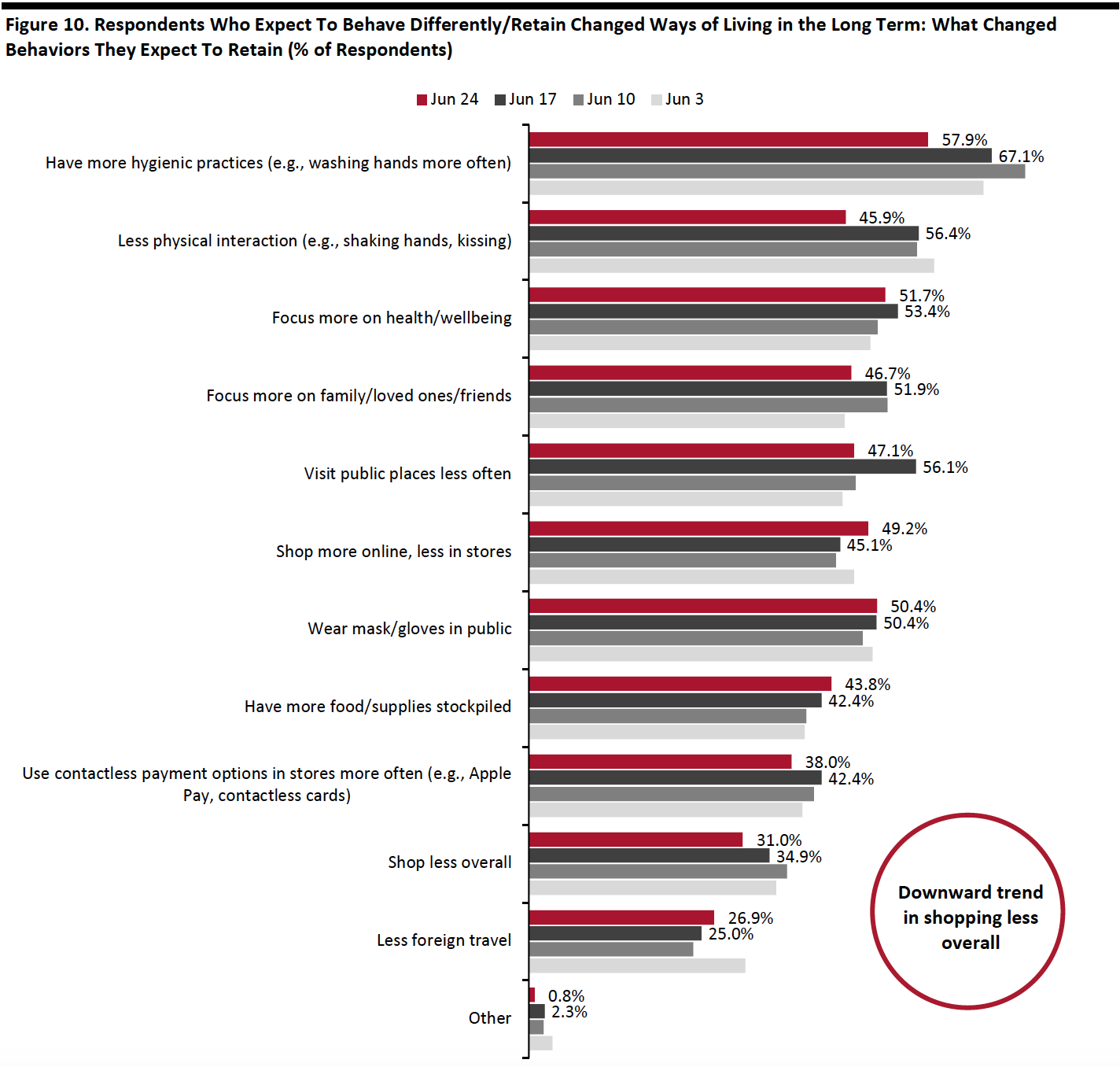 Respondents could select multiple options
Respondents could select multiple optionsBase: US Internet users aged 18+ who expect to behave differently in the long term/retain changed ways of living from the outbreak
Source: Coresight Research[/caption]
In the chart below, we focus on trending data in three of the metrics charted above. We represent these as a proportion of all respondents, to represent consumers overall, rather than as a proportion of those expecting to retain changed behaviors (which is what charted above).
Rebased to all respondents, we saw slight decreases in expectations to shop less overall. Some 18.2% of respondents expect to shop less overall, versus 21.3% last week. Expectations of shopping more online increased slightly compared to the previous week.
The proportion of respondents expecting to visit public places decreased after showing an upward trend from June 10. Some 27.7% expect to do so, compared to 34.3% last week.
[caption id="attachment_112150" align="aligncenter" width="700"]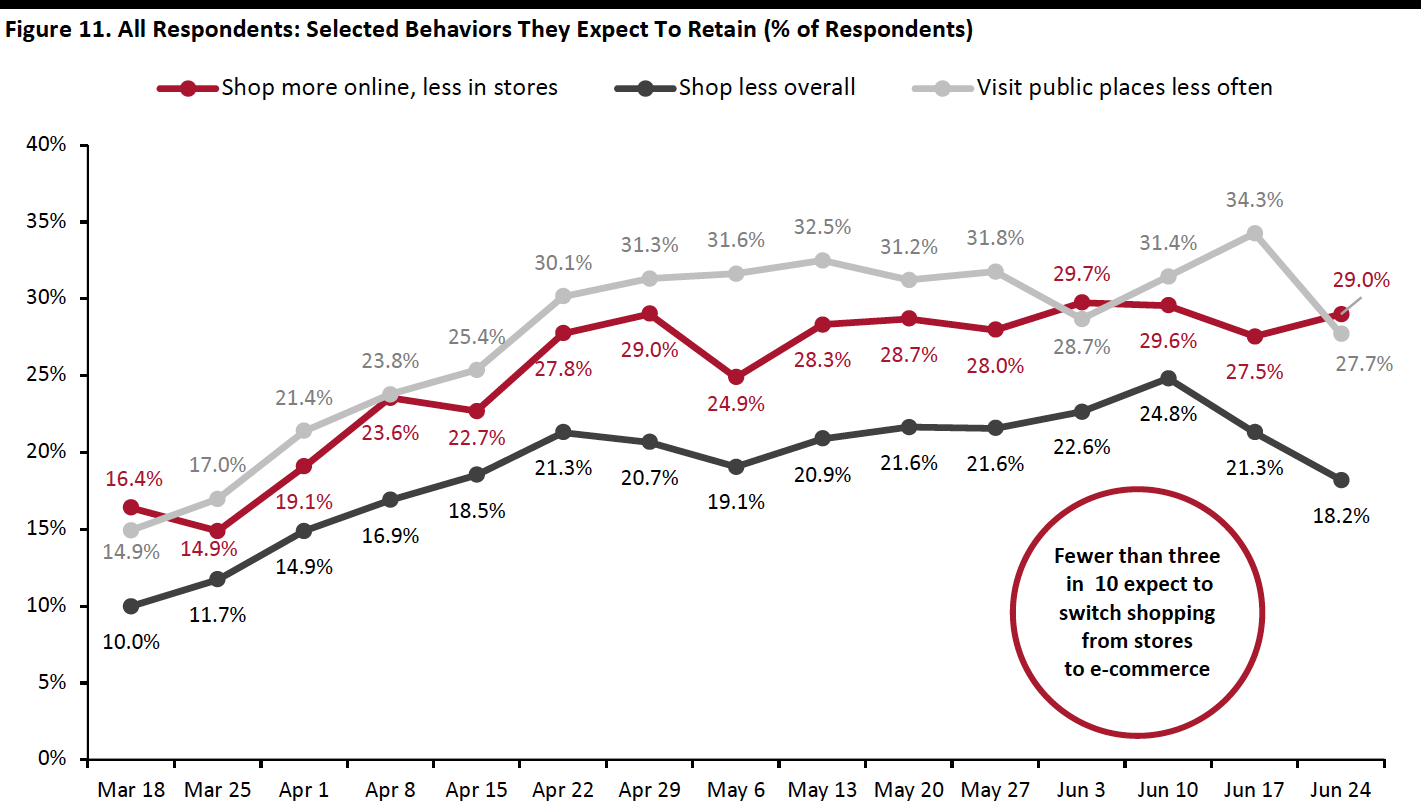 Base: US Internet users aged 18+
Base: US Internet users aged 18+Source: Coresight Research[/caption]
Methodology
We surveyed respondents online on June 24 (411 respondents), June 17 (432 respondents), June 10 (423 respondents), June 3 (464 respondents), May 27 (422 respondents), May 20 (439 respondents), May 13 (431 respondents), May 6 (446 respondents), April 29 (479 respondents), April 22 (418 respondents), April 15 (410 respondents), April 8 (450 respondents), April 1 (477 respondents), March 25 (495 respondents) and March 17–18 (1,152 respondents). The most recent results have a margin of error of +/- 5%, with a 95% confidence interval. Not all charted week-over-week differences may be statistically significant.